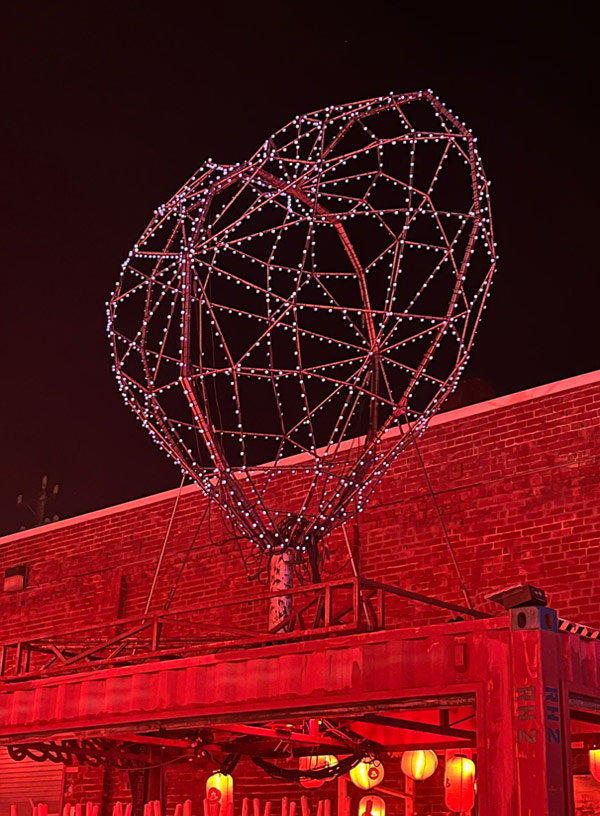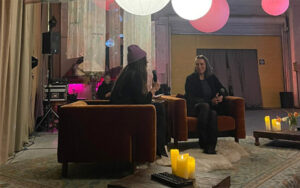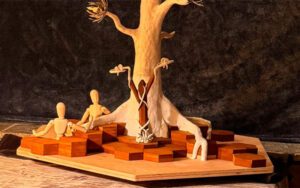By Ariel Sutro
We had the opportunity to participate in the Thrival Guide speaker series at the Robot Heart Residency, and boy, was it fun. Thrival Guide has made a particular focus of helping to explain how the greater community is bringing the art and environmental aspects of our Burning Man experience into the real world.
The gist of Saturday evenings’ presentations was centered around how to bring Burning Man art into the default. The secret is community involvement and galvanizing support across multiple agencies and resources – and a little bit of good luck…
The arc of the evening flowed from Dave Keane, discussing how he finds art anywhere and is constantly sourcing materials and putting in the extra time to repurpose found elements into his work with Folly Builders. Jeremy Crandell shared stories of
Julia Cortell of MassiveArts.org, and fellow member of the Coven, was in conversation with Jess Hobbes, Flux Foundation—about the legal and financial intricacies of Big Art and how you set up your can really inform what you can do with it afterward. e.g., Unless you build something understanding how it will fit perfectly onto a truck—it probably won’t. If you want it to be shown at a festival, you should build it with those engineering and safety specifications at the forefront.
It was a treat to look out into the audience as I sat down to begin my talk to see Marian Goodell smiling back at me. (Although slightly more concerned about getting my sequence of facts correct—knowing she could correct me. It was encouraging to have her show up to support the program as a whole.)
There were many hard-earned lessons shared, and helpful friends in the room.
I researched and presented on Patricia’s Green, in Hayes Valley, which provided an interesting case study of the process of getting something installed in public.
Patricia’s Green
The park was the long-requested result of several very active Hayes Valley residents, namely Patricia Walkup, Madeline, and XXX, spurred on by some luck from the Mayor’s office and strong leadership in the newly formed Black Rock Arts Foundation with ties to the SF Arts Commission to make it all come together over the course of ~ 10 years.
For many years Hayes Valley neighborhood was pretty rough. Despite being at the cultural heart of the City (with City Hall, War Memorial, Opera House, and Main Branch of the SF Public Library), it sat at the base of the Central Freeway and was overrun with crime and debris. A handful of local residents worked hard to galvanize the community—and actually got their hands dirty cleaning it up regularly.
It was the 1989 Loma Prieta earthquake that ultimately damaged the Fell Street off-ramp of the Central Freeway that presented the most significant new opportunity to revitalize the area. Although hotly contested (Richmond & Sunset residents certainly wanted the freeway rebuilt, as it was a reliable artery from downtown to their homes), after 3 ballot measures, the Octavia Blvd project was ultimately approved.
In 2005, the park was completed, and local residents were eager to install Art to attract people to stop and enjoy the area. Around this time, Gavin Newsom read an article about an installation in trouble in the North Bay. Turns out, he was interested in building a temple to honor the dock workers in San Rafael, but the Taqueria leading the permit process didn’t actually have control of the parcel they were trying to have permitted for the structure. Gavin brought it to the attention of the Arts Commission and suggested that the temple may fit what Hayes Valley was looking for.
The newly formed Black Rock Arts Foundation, led by Leslie Pratchett, had ties to the Arts Commission, and together, they negotiated the placement of the Best Temple at Patricia’s Green instead.
A permanent platform for temporary art was ultimately designed by local (formerly Kiwi) structural engineer Mark Sinclair.
“The Temple became our model of how artists, city officials, and community members can collaborate to create meaningful public artwork – art that addresses the specific needs of, reflects the unique character of, and serves a connective function for the community.”
Black Rock Arts Foundation (BRAF)
I had the pleasure of spending a couple of years working on the Civic Arts and Fundraising committees for BRAF under the executive direction of Tomas McCabe. Likely because it coincided with my time as a ‘Burning Man Artist’ having just come off of Trojan Horse in 2011, and I was acutely aware of how much work Big Art requires—and excited to see those scenes—but those were GREAT years for public art in SF. In addition to helping with the yearly transition of art in Hayes Valley, we hosted the annual Artumnal Ball (aka Burning Man Prom) and saw something on the order of 30 pieces of artwork installed throughout San Francisco and beyond.

Some other highlights from the evening and how they are interconnected;
City Arts, City Parks
- Ben Davis, Illuminate.org, and Phil Ginsburg, Head of Recreation & Parks Department
Many of you know my Dad, Big Jim Sutro. Well he worked for many years as the Superintendent of Recreation and Parks Department, and had great things to say about Phil as both a great boss and a smart politician. (He’s also a Dartmouth alum with Candace Locklear, another great connection to our village).
- Seeing Phil and Ben in conversation felt like being in the garage with them—recognizing their partnership has enabled both of them to push the needle much farther together. Ben’s organization, Illuminate the Arts, has been wildly successful in raising friends and resources to support ambitious ‘decorative lighting’ (my words) projects in our hometown. The Bay Lights, the XXX mile-long installation by Leo Villareal, first installed on the Bay Bridge in 2014, is the most notable of those projects. It has absolutely changed the view of and within SF, has delivered on its’ promise of revitalizing the waterfront, and bringing new tourism dollars to enjoy the City. And, it’s just lovely.
- The piece was originally conceived and approved as a temporary installation (this is smart and a theme we continue returning to in this post and in practice because it works!). Initially only getting approval for a 2-year installation, it was easier for everyone to agree to simply “try it” and see how we liked it. We all fell in love, the original term was extended, and now a new $10M campaign is currently nearing completion to upgrade the systems to a permanent installation that is visible to the North and south of the bridge.
Our Village alumnae Erin Douglas (‘22) and Zulu Heru (‘23) were interviewed by Satya of Thrival.Guide about their process as new artists at the Event.
Douglas was also interviewed by our own Jen Randle during a conversation on 11/17.
NO DANCING
One of my favorite stories was hearing from Sri of Looking Up Arts. These guys are smart, creative and truly building art that builds community. His story about parking a massive flamingo next to the park in Bernal after driving home from Burning Man, because they truly didn’t have a home for the piece, was illustrative.
They didn’t let that happen this year, and ‘No Dancing’ found its home in Golden Gate Park almost immediately post-event.
I was happy to take my boys to see it, as that is truly what motivates me to help bring our Art and Culture into the default. In the words of Larry Harvey, “moving the needle on subculture is what it’s all about!”
Reviews are mixed—but that’s what makes it Art!


